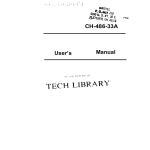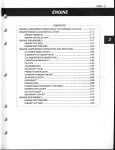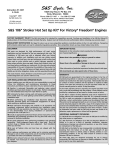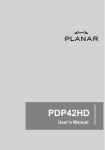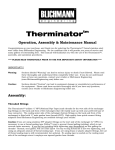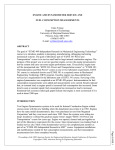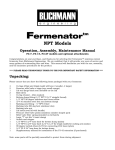Download Oiling System
Transcript
206 MOPAR PERFORMANCE PARTS Oiling System INTRODUCTION The 4.0L engine uses a pressure feed, full flow filtration oiling system utilizing a gear-type positive displacement pump is mounted at the underside of the block opposite the No. 4 main bearing (Figure 4-37). The pump draws oil through the screen and inlet tube from the sump at the rear of the oil pan. The oil is driven between the drive and idler gears and pump body, then forced through the outlet to the block. An oil galley in the block channels the oil to the inlet side of the full flow oil filter. After passing through the filter element, the oil passes from the center outlet of the filter through an oil galley that channels the oil up to the main galley which extends the entire length of the block. The oiling system has a capacity of 5.7L (6 quarts). (For more oiling system specifications, refer to 4.0L Engine SpeciJications, ‘Engine Assembly’ section of this chapter.) Galleys extend downward from the main oil galley to the upper shell of each main bearing. The crankshaft is drilled internally to pass oil from the main bearing journals (except No. 4 main bearing journal) to the connecting rod journals. Each connecting rod bearing cap has a small squirt hole. Oil passes through the squirt hole and is thrown off as the rod rotates. This oil throw-off lubricates the camshaft lobes, camshaft position sensor drive gear, cylinder walls, and piston pins. The hydraulic valve tappets receive oil directly from the main oil galley. Oil is provided to the camshaft bearing through galleys. The front camshaft bearing journal passes oil through the camshaft sprocket to the timing chain. Oil drains back to the oil pan under the No. 1 main bearing cap. The oil supply for the rocker arms and bridged pivot assemblies is provided by the hydraulic valve tappets which pass oil through hollow pushrods to a hole in the corresponding rocker arm. Oil from the rocker arm lubricates the valve train components and then passes down through the pushrod guide holes in the cylinder head, past the valve tappet area, and returns to the oil pan. The stock lubrication system will be adequate for normal passenger car operation. However, in any case where DaimlerChrysler engines are subjected to unusually high crankshaft rotational speeds (over 6,000 rpm), acceleration, deceleration, or cornering loads, special precautions must be taken with the engine’s oiling system. Not only must an engine’s oiling system be modified for adequate lubrication, but it must also be modified to achieve optimum engine power output. Troubleshooting Oiling the valve gear in a standard engine is virtually automatic, as long as the engine has oil pressure. In a modified, high performance engine, it can be another story. When recommendations are followed, most racers will have no oiling problems. When oiling problems do develop, they generally manifest themselves as burned pushrod tips, scuffed valve tips, scuffed and burned rocker arms, broken pieces, etc. Unfortunately, the pieces that look the worst usually aren’t the cause of the problem. In the majority of cases relating to valve gear oiling, it’s not a matter of what you should do, but what you should not do. The problems mentioned are the result of poor oiling, assuming the engine itself is being oiled properly (no foam, no zero psi, etc.). The first thing to check is that a camshaft bearing hasn’t “turned” so that its oiling holes aren’t lined up with the holes in the block. Next, be sure the passage from the camshaft to the block’s deck isn’t blocked or restricted. This is usually done with a long handled bottle brush. At the deck surface of the block, it is common for racers to install a restrictor. This is not recommended and, if found, should be removed. If you “smoked out” your pushrods or scuffed the valve tips, you’ve probably found the cause. Next, check the head gasket and cylinder head itself for oiling hole alignment. At this point you can have two different types of problems depending on whether your engine uses hydraulic rockers or mechanical rockers. A problem with hydraulics is most likely caused by an oil leak that prevents oil from reaching the rockers. Spacers used between the rocker stand and the rocker shaft will, over an extended period, cause these problems because of leakage. Also, the rocker shaft could be installed incorrectly (upside down, reversed, etc.). Problems occumng with mechanical rockers can be much more complicated. Since there is no need to put spacers between the rocker shaft and the pedestal, a leak there would be unusual. Rocker shaft installation is very critical. Banana grooves are usually added to mechanical valve gear rocker shafts to improve oiling of the rocker itself. Bushed rockers are more tolerant of low oil conditions, but standard mechanical rockers should be adequate for most applications. At this point, with oil to the rocker, it must be distributed to the valve tip and the pushrod tip. Accomplishing this is very tricky. Exactly where and how these holes are located is very critical and each engine is unique. There is another “trick” with mechanical rockers that should be considered. The proper (ideal) adjustment for the rocker adjusting screw is to have only one thread showing below the rocker arm with the valve lash set properly (two may be okay, three shaky, etc., but high rpm makes one thread showing the most desirable). This requires custom length pushrods for every engine. If you’ve “smoked” your pushrods and you had all the threads showing below the rocker (i.e., pushrod too short), more oil to the valve gear won’t cure the problem. Only longer pushrods will do the job. TAPPET GALLERY Figure 4 - 37 208 MOPAR PERFORMANCE PARTS OILING SYSTEM PERFORMANCE CONSIDERATIONS Choosing the Correct Oiling System The oiling system to be used on a high performance engine is determined by the output level of the engine and the type of application that the engine is going to be used for. Oil capacity is the first consideration in a basically stock system used for high performance. This means that the first step for bracket racing is to deepen the stock pan 2“ along with lowering the pick-up the same amount. The next step is a Super Stock race pan and high volume oil pressure pump. The last step is a dry sump which is particularly important in oval track and high performance drag race vehicles that are built low to the ground. During your engine build-up, after the camshaft has been chosen and the engine’s application is known, the oiling system type should be decided on so that any block modification (especially if a dry sump and roller lifters are to be used) can be done before the block is assembled and it’s too late. Oiling System Passage Requirements It is important to note that oil pump performance at high engine speeds can be most easily improved by reducing restrictions on the suction side of the oil pump. Reducing flow restriction on the suction side of the pump is much more significant than reducing flow restriction on the pressure side of the pump. Oil pump suction pipe diameter should be very generous. Caution: Modified oil pump suction pick-ups must be fitted with a protective screen to prevent the pump from ingesting debris such as metal shavings, broken valve spring tips, etc. Oil Flow to Connecting Rod Bearings For increased oil flow to connecting rod bearings, 360” fully grooved main bearing sets should be used. Note: It is NOT recommended that the crankshaft be grooved because that will weaken the crankshaft. Oil Restriction It seems that some magazine article or book is always recommending that an engine’s oil be restricted in some way. Some suggestions have no real effect, but those restricting oil to the upper valve gear can be quite harmful. We DO NOT recommend restricting oil flow to the upper valve gear. Leave all the passages stock size and be sure that they are unobstructed. The usual result of oil restriction to the upper valve gear is “smoked out” pushrod tips, scuffed valve tips, scuffed or burned rockers, or scuffed valve guides. These are expensive ways to find out what doesn’t work. Full roller rocker arms can cut down on the valve gear’s oil requirement but are generally expensive. In racing, as the rpm is increased, the valve gear needs more oil. If you have extra time available in your engine building process, helping the oil in the cylinder head return to the pan can be beneficial. Helping the oil return past the crankshaft without getting on to the crankshaft is the best place to spend your time. Restricting oil to the tappet galley with roller lifters is a very common practice (and required for 3.9L V-6 engines with high lift roller camshafts). However, restricting oil to the upper valve gear is NOT recommended. The oil is fed to the upper valve gear through mating passages in the block and head. Restricting these passages cuts down on the amount of oil available to the valve gear (valves, rockers, pushrods). This causes two problems. At.high rpm, rocker arms like to “shake off’ the oil that is used to lubricate valves and pushrod tips. In most cases, the engine needs all its designed oil flow to keep its durability high and to minimize parts wear. The other problem occurs at low speed where the oil pressure drops to its minimum. In this condition, the valve gear, being the furthest from the oil pump, gets very little (if any) oil. The loads are low but with so little oil, any less can cause accelerated wear. In either case, scuffed valve tips, burned pushrod ends, and galled rockers can be the result, which is why oil restriction to the heads is not recommended. OIL PUMP A gear-type oil pump is mounted at the underside of the cylinder block opposite the No. 4 main bearing (see Figure 2-78). Oil pump removal or replacement will not affect distributor timing because the distributor drive gear remains in mesh with the camshaft gear. The stock oil pump is adequate for normal operation if it is up to specifications. The pump must turn freely when assembled. Heavy Duty Oil Pump When the going gets tough, you’ll want to be sure and supply as much oil to your engine as possible. This heavy duty high volume pump will do the job and take the most severe punishment. For 4.0L engines only. P4529227 Heavy duty oil pump. High Volume Oil Pump Assembly For many years, Mopar Performance Parts has supplied parts for oiling systems. Our previous parts have come as kits that the racer had to put together himself, in many cases using a stock oil pump as a starting point. Mopar Performance Parts now offers a high volume, high performance oil pump assembly for 4.0L Power Tech engines (P4529241). It offers a 25% increase in volume over the stock pump and comes fully assembled and ready to bolt on the engine. i 4.0L POWER TECH IN-LINE 6 (OILING SYSTEM) OIL PUMP SERVICE PROCEDURES High Volume Oil Pump This Mopar Performance Parts high volume oil pump is similar to the heavy duty oil pump (P4529227), except that it has larger rotors for a 25% increase in capacity. For 4.0L engine only. P4529241 High volume oil pump. Oil Pressure Requirements Oil pressure requirements for the 4.0L engine are as follows: At Idle Speed (600 rpm) ............13 psi ................... 89.6 kPa At 1,600+rpm ........................ Oil Pressure Relief .................... 209 37-75 psi ..........255-517 kPa 75 psi .................... 517 kPa Oil Pump Priming After an engine build (or re-build), the lubrication system should be checked to ensure that it is supplying pressure to the bearings before any attempt is made to start the engine. If the engine is running without oil pressure even for a few seconds, there will be extensive damage done to the engine. After installing a mechanical oil pressure gauge (only if your vehicle is not already equipped with an oil pressure gauge), remove all the spark plugs in order to relieve the compression in the cylinders and to prevent the engine from starting. The engine should be turned over with the starter motor until the oil pressure gauge shows a reading of over 10 psi. Once you have determined that the engine does have oil pressure, the spark plugs may be reinstalled and the engine may be started. When the engine starts, the gauge should show a minimum reading of 89.6 kPa (13 psi) at 600 rpm (idle speed). Warning! If the gauge does not register any pressure when the engine is cranked with the starter motor, DO NOT TRY TO START THE ENGINE. Running an engine with no oil pressure for even a couple of minutes can cause serious damage. If the gauge does not register any pressure when the engine is cranked with the starter motor, go through your lubrication system and check it carefully. Make sure there is sufficient oil in the pan. Also be sure that the pickup is connected and that the oil pickup is fully submerged. Make Sure the pickup tube does not have any leaks where air might be entering the system. Make sure the oil pump is working properly. Removal 1. Drain the engine oil. 2. Remove the oil pan. Refer to the proper service manual for the procedure. Caution: DO NOT disturb the position of the oil inlet tube and strainer assembly in the pump body. If the tube is moved within the pump body, a replacement tube and strainer assembly must be installed to ensure an airtight seal. 3. Remove the oil pump retaining bolts, oil pump and gasket. Gear End Clearance Measurement Remove the cover retaining bolts and cover from the pump body. 1. Preferred Method a. Place a strip of Plastigauge (P4286819) across the full width of each gear (Figure 2-79). b. Install the pump cover and tighten the bolts to 8 Nom (70 in-lbs) torque. c. Remove the pump cover and determine the amount of clearance by measuring the width of compressed Plastigauge with the scale on the Plastigauge envelope. Correct clearance by this method is 0.051-0.152 mm (0.002-0.006"). The preferred measurement is 0.051 mm (0.002"). If the gear end clearance is excessive, replace the oil pump assembly. Plastigauge When reassembling your engine you'll need a variety of Plastigauge to measure bearing clearances. This popular assortment includes one blue strip for .004" - .009" tolerances, two red strips for .002" - .006" tolerances, and two green strips for .001" - .003" tolerances. Each strip is 12" long. P4286819 Plastigauge assortment. 2. Alternate Method a. Place a straightedge across the ends of the gears and the pump body. b. Select a feeler gauge that fits snugly but freely between the straightedge and the pump gears (Figure 2-80). Using this method, the correct clearance is 0.051-0.152 mm (0.002-0.006"), with the preferred measurement being 0.051 mm (0.002"). If the gear end clearance is excessive, replace the oil pump assembly. ..... 210 MOPAR PERFORMANCE PARTS Gear-to-Body Clearance Measurement Installation 1. Measure the gear-to-body clearance by inserting a feeler gauge between the gear tooth and the pump body inner wall directly opposite the point of the gear mesh (Figure 2-81). 1. Install the oil pump with a replacement gasket. Tighten the bolts to 23 Nom (17 ft-lbs) torque. (Refer to Figure 2-78.) 2. Select a feeler gauge which fits snugly but freely. 3. Rotate the gears to measure each tooth-to-body clearance in this manner. 4. The correct clearance is 0.051-0.102 mm (0.0020.00411).The preferred clearance is 0.051 mm (0.002”). 5. If the gear-to-body clearance is more than specified, replace the idler gear, idler shaft and drive gear assembly. 6 . Remove the cotter pin and slide the spring retainer, spring and oil pressure relief valve plunger out of the pump body. 2. Install the oil pan with replacement gaskets and seals. Refer to the proper service manual for the procedure. 3. Fill the oil pan with clean engine oil to the specified level. OIL PICK-UPS An oil pick-up is used in virtually every engine. It’s not a fancy device and doesn’t get much attention ,by the average racer. In spite of this, the pick-up is very important to your engine. If it does not do its job, then the engine is in real trouble and could very easily fail. Note: Two relief valve plunger sizes (standard and oversize) are available. When replacing the valve, ensure that the correct replacement valve and either the standard size or 0.254 mm (0.010”)diameter oversize plunger is obtained and installed. Once the pan is removed from the engine, the pick-up sticks out away from the crankshaft and bottom of the block. As such, it is very vulnerable and can be easily damaged. Removing it from the block, which has to be done to allow the engine to be rebuilt, can also be tricky and cause the pick-up to be damaged. One common damage is,to bend it. Typically, when you try to bend it “back into place” you will break or crack it. A crack will allow air to get into the oil system and be fed directly to the bearings which will cause the obvious failure. A crack can also cause the oil pump’s “prime” to be lost. Used pick-ups’can also be very difficult to clean. For any of these situations, obtaining new parts will solve your problem. Remember, they are designed to work in the stock pan. If the pan is changed, you may have to modify the pick-up, but now you will have a.new part to start with for your modification. 1. Install the oil pressure relief valve plunger, spring, retainer, and cotter pin. OIL PAN 7. Inspect for binding condition during disassembly. 8. Clean or replace as necessary. 9. The oil inlet tube and strainer assembly must be removed to allow removal of the relief valve. Install a replacement inlet tube and strainer assembly. Assembly 2. If the position of the inlet tube in the pump body has been disturbed, install a replacement inlet tube and strainer assembly. Apply a light film of Permatex No. 2 sealant, or equivalent, around the end of the tube. 3. Use an oil pump inlet tube installer tool to drive the tube into the body (Figure 2-82). Ensure that the support bracket is properly aligned. 4. Install the idler gear and the drive gear assembly. Inspect the gears to ensure that a binding condition does not exist before installing the oil pump. 5. To ensure self-priming of the oil pump, fill the pump with petroleum jelly before installing the oil pump cover. DO NOT use grease! 6 . Apply a bead of Loctite 515, or equivalent, and install the pump cover. 7. Tighten the cover bolts to 8 Nam (70 in-lbs) torque. The 4.0L engine standard production oil pan is made of laminated steel and has a single plane sealing surface. The oil pan gasket is a one piece steel backbone silicone coated gasket. Removal and replacement procedures vary depending on vehicle type and model year. Refer to your service manual for removal and replacement procedures. Oil Pan Gasket Set Includes both the sides and the ends. For 4.0L engine only. P4529244 Oil pan gasket set. 4.0L POWER TECH IN-LINE 6 (OILING SYSTEM) 211 OIL PAN PERFORMANCE CONSIDERATIONS DRY SUMP OILING SYSTEM Windage Losses For drag racing, a dry sump system should only be considered for vehicles that have almost no ground clearance. However, dry sump oiling systems can be very advantageous in an oval track vehicles. Dry sumps provide more ground clearance so the vehicle can sit lower. This is because dry sump pans are very shallow. This allows the centerline of the crankshaft to get closer to the ground while maintaining the same actual ground clearance. (Ground clearance is usually specified and enforced by the sanctioning body.) Every engine that uses oil for lubrication has windage losses. Controlling windage loss can help make more power. This holds true for any engine. The more engine speed that you use, the worse the windage loss becomes. Remember, less windage means more horsepower! So what is windage and why does less of it make more power? Windageis the friction caused by the crankshaft and connecting rod assembly rotating through an air-oil mixture. Windage trays are designed to “scrape” the oil that is thrown off the crankshaft away from the crankshaft and into the pan, and keep the oil that is in the pan from coming up for the crankshaft to drag through. Each connecting rod and main bearing has oil and oil pressure in it and, because of the oil pressure, some will leak out and get in the way of the rotating crankshaft assembly. Then there’s the oil that goes to the head to lubricate the valve gear that has to get back to the pan somehow. This usually means that it falls back past the tappets and on to the crankshaft. Smart racers will work extra hard to install special drains so that the return oil doesn’t fail on to the crankshaft. Windage Tray Every high performance engine should have a windage tray. It goes between the oil pan and the block. Only the windage tray and two oil pan gaskets are required for installation. The only time a windage tray should not be used is with a custom-made race oil pan. With a custom-made race pan, the windage tray should be removed resulting in increased vehicle performance. If the vehicle slows down when the tray is removed, the pan has been compromised too much and the tray should always be used with that particular pan. Stock (Production) Oil Pan Modifications The standard pan can be helped by reworking the sump so it is 2” deeper. A longer oil pick-up must also be installed at the same time. A deepened pan can also be used. With this pan the pick-up must also be lengthened, or a strainer and pipe assembly, which is designed for use with the deepened pan, should be purchased. With any oil pan capacity or shape change, the dipstick should be carefully recalibrated. Be sure to fill the oil filter before calibrating! With either of these pans installed, the ground clearance will be reduced and the pan will no longer be protected. For added pan protection, a skid plate should be added and the vehicle should be driven with increased care. ~ All production (stock) oil pans are wet sump designs. With a dry sump, the oil that is being stored in preparation for being pumped back into the engine is stored outside the engine (or remotely), usually in a separate tank (with baffles, etc.) located ahead of the engine. A race wet sump pan would have a large capacity rear sump located directly under the crankshaft. Production wet sumps are small and may be located in the center, front or rear. A race wet sump ideally designed would be 9 to 10 inches deep. But many professionallybuilt race vehicles are built so low to the ground that there is no room for this style pan. Enter the dry sump. However, a properly designed dry sump system is expensive. Therefore, a racer who doesn’t have the crankshaft dragging on the ground doesn’t need a dry sump because it’s money spent for no gain. Here, look closely at a race wet sump. There is performance in a good wet sump system race pan. A dry sump oil system should be used whenever a deep oil pan cannot be used. There is approximately 40 hp lost to a shallow, wet sump pan. The dry sump system consists of an oil tank, scavenge pump, and a pressure pump. The oil pump used is a multistage, external assembly with two or three stages for scavenge and a pressure stage. Drag race engines require two scavenge stages, oval track engines require three. The pump should be run at .5 to .6 engine speed. The oil tank for drag racing use can be as small as 5 qts., while an oval track racing tank should be 3 gallons. Now that we know all the parts, let’s see how it works. The pressure stage picks oil up from the tank, then sends it to an external oil filter, and then to the engine. The engine then gets oiled and dumps the oil back in the pan where the scavenge stages pick up the oil and return it to the tank. The tank is vented to the valve cover to equalize pressures. Contact Weaver Brothers for further details and dry sump hardware. In a stock pan, especially a deepened pan, the rear acceleration baffle is very important. It keeps oil from mnning up into the rear cylinders and slowing down the last rod journal with increased drag. The rear acceleration baffle must be sealed to three walls of the sump (back and two sides) or it becomes useless. Weaver Brothers 1980 Boeing Way Carson City, NV 89706 212 MOPAR PERFORMANCE PARTS OIL COOLERS I ENGINE OIL VISCOSITY GRADES Engine Oil Cooler This specially engineered, finned radiator design oil cooler prevents engine oil from overheating, thus ruining its lubricating characteristics. This cooler is ideally suited for endurance-type engine applications and utilizes 112" pipe thread fittings. Measures 11" x 12" x 1-1/2". I _- k B FP \s P3690956 -20" -29" IO" -12" 20" 32" -7' 60" 16" 80" 27" 100" 38" Temperature range anticipated before next oil change Engine oil cooler. Heavy Duty Engine Oil Cooler Figure 4 - 38 i This heavy duty steel, full flow oil cooler is the best way to ensure peak engine oil cooling efficiency under heavier than normal driving conditions. It is thermostatically controlled to provide continuous cooling of your engine's oil. Install in oil filter circuit. Oil circulates in a continuous loop from the pan, through the pump, then to the cooler. Includes built-in relief valve. Designed for simple installation. Cooler is 1-1/2" thick. Measures 6" W x 18" L. P4876917 0" -18" I , I Heavy duty oil cooler. Universal Oil Cooler Packages Special universal coolers mount between engine and oil filter to circulate heater core coolant to reduce oil temperatures. P4529690 Universal oil cooler package, standard. P4529691 Universal oil cooler package, extra cooling. OIL Use only high detergent and additive engine oil. The oil I must meet Mil Spec MS-DG. DO NOT use viscosity improver oil additives. The only oil additives you should consider using are anti-scuff additives, such as Mopar Engine Oil Supplement. Anti-scuff additives should be used only for running in and should be drained from the oiling system before racing (be sure to re-fill the engine oil to the correct level before re-starting the engine). SAE Viscosity An SAE viscosity grade is used to specify the viscosity of engine oil. Use only engine oils with multiple viscosity such as 5W-30 or 1OW-30. These are specified with a dual SAE viscosity grade which indicates the cold-to-hot temperature viscosity range. Select an engine oil that is best suited to your particular temperature range and variation (Figure 4-38). Oil Level Inspection Caution: DO NOT overfill crankcase with engine oil, pressure loss or oil foaming can result. Inspect engine oil level approximately every 800 kilometers (500 miles). Unless the engine has exhibited loss of oil pressure, run the engine for about five minutes before checking oil level. Checking engine oil level on a cold engine is not accurate. To ensure proper lubrication of an engine, the engine oil must be maintained at an acceptable level. The acceptable levels are indicated between the ADD and SAFE marks on the engine oil dipstick. 1. Position vehicle on level surface. 2. ' With engine OFF, allow approximately ten minutes for oil to settle to bottom of crankcase, remove engine oil dipstick. 3. Wipe dipstick clean. 4. Install dipstick and verify it is seated in the tube. 5. Remove dipstick, with handle held above the tip, take oil level reading. 6. Add oil only if level is below the ADD mark on dipstick. Engine Oil Change Change engine oil at mileage and time intervals described in Maintenance Schedules of your owners or service manual. Run engine until achieving normal operating temperature. 1. Position the vehicle on a level surface and turn engine off. 2. Hoist and support vehicle on safety stands. 3. Remove oil fill cap. 4. Place a suitable drain pan under crankcase drain. 4.0L POWER TECH IN-LINE 6 (OILING SYSTEM) 213 5 . Remove drain plug from crankcase and allow oil to drain into pan. Inspect drain plug threads for stretching or other damage. Replace drain plug if damaged. Installation 1. Lightly lubricate oil filter gasket with clean engine oil. 6. Install drain plug in crankcase. 2. Thread filter onto adapter nipple. When gasket makes contact with sealing surface (Figure 4-39), hand tighten filter one full turn. DO NOT over tighten. 7. Lower vehicle and fill crankcase with specified type and amount of engine oil described in this section. 8. Install oil fill cap. 3. Add oil, verify crankcase oil level and start engine. Inspect for oil leaks. 9. Start engine and inspect for leaks. 10. Stop engine and inspect oil level. ENGINE OIL FILTER All engines are equipped with a high quality .full-flow disposable type oil filter. DaimlerChrysler recommends a Mopar or equivalent oil filter be used. Removal 1. Position a drain pan under the oil filter. 2. Using a suitable oil filter wrench, loosen the filter. 3. Rotate the oil filter counterclockwise to remove it from the cylinder block oil filter boss, 4. When filter separates from adapter nipple, tip gasket end upward to minimize oil spill. Remove filter from vehicle. 5. With a wiping cloth, clean the gasket sealing surface (Figure 4-39) of oil and grime. Figure 4 - 39








